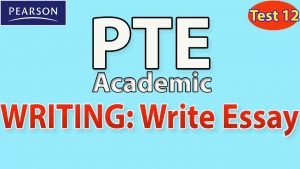PTE
To complete a PTE Academic test, you will need to attend a secure Pearson test center. You will use a computer and headset to listen to, read and respond to questions.
During the three-hour test session, there are three main parts to the test: speaking and writing (together), listening and reading. There is also an optional 10-minute break between the reading and listening parts. During the test, you will find twenty different question formats, ranging from multiple choice through to essay writing and interpreting information.
PTE Academic assesses real-life, academic English, so you will hear excerpts from lectures and view graphs and charts. You will hear a range of accents in the test, from British and American to non-native speakers, so you will be exposed to the type of accents you will encounter in everyday life.
PTE Academic
The Pearson Test of English Academic
PTE Academic is a computer-based academic English language test aimed at non-native English speakers wanting to study abroad. It tests Reading, Writing, Listening and Speaking.
Questions often test 2 skills together, such as listening and reading or reading and speaking. The whole test is done in a single session, lasting 3 hours and is taken sitting at a computer in a secure test environment. The speaking part of the exam is done at the computer. Your voice is recorded and sent for marking.
One advantage of this test is that you get your results very quickly; in about 5 days.
The cost varies by country but is in the range of $150-$210.
PTE Academic is a multi-level test, like IELTS, TOEFL and TOEIC.
Test Format
Part 1: Speaking & Writing
(77 – 93 minutes)
- Personal introduction
- Read aloud
- Repeat sentence
- Describe image
- Re-tell lecture
- Answer short question
- Summarize written text
- Essay (20 mins)
Part 2: Reading
(32 – 41 minutes)
- Multiple choice, choose single answer
- Multiple choice, choose multiple answers
- Re-order paragraphs
- Reading: Fill in the blanks
- Reading & writing: Fill in the blanks
Part 3: Listening
(45 – 57 minutes)
- Summarize spoken text
- Multiple choice, choose multiple answer
- Fill in the blanks
- Highlight correct summary
- Multiple choice, choose single answer
- Select missing word
- Highlight incorrect words
- Write from dictation
Quick Tips to Improve Score in Essay Writing
- Be attentive of the instructions i.e. the word limit (200-300 words)
- Read the topic and know the type of essay
- Ensure that you write in academic English language
- Do not use bullet points
- Write in clear and concise paragraphs
- Avoid the jargons at all cost
- Make correct use of the phrases
- Show variations of simple, compound and complex sentences
- Be very careful with grammar, for example, tenses, singular/ plural
- Be sure to write correct spellings
- Take note about capitalisation at the start and also in between the sentences
- Correct punctuations will add to the marks
- Support your ideas with relevant examples
- Never mention too many ideas in a single paragraph as the chances of many of them being irrelevant are high
- Always proofread the essay after completing it by spending 2-3 minutes
- Check for all the minor and major mistakes that you used to make while practising especially spelling errors
Quick Tips to Improve Score in Summarize Written Text
- Read the instruction carefully and notice the word limit i.e. between 5-75 words
- Write in only ONE sentence (only ONE sentence!!)
- Practise to write complex sentence. Use complex sentence wisely
- Use the connectors aptly, because grammar matters a lot
- Extract the main idea of the given text
- Notice the word count at the bottom
- Recheck the sentence for punctuations, grammar & spellings errors
PTE Writing tip #1: Keep it simple.
Long, convoluted sentences with lots of punctuation are your enemy. The more you try to extend your sentences, the more likely you will be to make grammar and punctuation mistakes! The Pearson test assessors are not looking for long, impressive sentences; they are looking for sentences that are clear and logical.
Look at this example:
Although many people are in support of standardized testing, I disagree with it for a few reasons and I will talk about these reasons below, including about the fact that it allows students to cheat more easily and stifles creativity in people.
WOW. What a complicated sentence! The ideas are all there, but they sure are hard to follow.
Let’s try this instead:
Although many people are in support of standardized testing, I am not one of them. In my opinion, standardized testing makes it easier for students to cheat and stifles their creativity. I will discuss these ideas further below.
When I wrote the PTE exam, I adopted this simple writing style and I took absolutely no risks with my punctuation. My result was a score of 90 across all writing related skills, including written discourse and grammar.
Want to see some examples of PTE 90 level essays? Download 5 free essay samples here:
PTE Writing tip #2: Take the time to plan your points.
A lot of people run out of time writing their PTE essay because they change their minds about their arguments halfway through and must begin again. People often think that the best tactic is to just begin writing and get the ball rolling, and that the ideas will follow. Unfortunately, this is rarely how it works and in general, creating a plan will save you from having to stop and restart.
People will often say that they don’t write out an essay plan because they’re afraid of wasting valuable time. I understand this logic, but I can promise you that it really doesn’t take long to jot down a few quick ideas on your erasable noteboard booklet, especially if you have a method. The E2Language method breaks “planning” into 3 easy steps that take less than two minutes. You can find this method in our PTE “Write Essay” webinar, included in our PTE course preparation packages.
Here is a “planning” hint from our webinar:
PTE Writing tip #3: Use the “right” format.
When many of our PTE students hear the word “essay”, they automatically understand it to mean a text with 5 paragraphs that includes an introduction, three arguments and a conclusion. They panic because they realize how unrealistic it is to write all of that content in just 20 minutes with a 300-word limit!
Here’s the thing: you are NOT expected to structure your essay this way. In other words, the standard 5-paragraph template that everyone knows is not the “right” template for the PTE essay section. You don’t have enough time to complete an essay in this style, and you probably won’t be able to think of enough arguments to support your ideas either!
So, what can you do instead?
I want you to keep in mind that there may be multiple “right” answers when it comes to structuring your essay, so here are two examples of essay structures that consistently work on for PTE:
Structure 1: Weigh the arguments
Paragraph 1: Introduction of the topic
Paragraph 2: Arguments for
Paragraph 3: Arguments against
Paragraph 4: Conclusion – tell the reader which argument is most convincing (in your opinion)
Structure 2: Choose a side and stick with it
Paragraph 1: Introduction of the topic
Paragraph 2: Argument 1 (e.g. against)
Paragraph 3. Argument 2 (e.g. against)
Paragraph 4: Conclusion – sum up the arguments you made in paragraph 1 and 2
Each of these paragraphs need only be a few sentences long to clearly get your point across. Again, for more information about essay structure methods, our PTE “write essay’ webinar is a great place to start! In addition, check out this great article about writing essay conclusions in English.
PTE Writing Bonus Tip: Brush up on your academic vocabulary!
I am a native speaker of English who has published academic articles in the past and I STILL didn’t get full vocabulary points on the PTE. I got an 89, so I’m not that upset – but my score really illustrates to me how important it is to know the vocabulary that the PTE is looking for.
How can you build this vocabulary? Well, you can READ! Read newspaper articles, read novels, read autobiographies, read whatever you can get your hands on! Reading not only increases your vocabulary, it enhances your understanding of context. We’ve all had an experience where we’ve attempted to use a new and exciting ‘big word’, only to have someone point out that we’ve used it incorrectly!
Speaking of reading, E2Language has an academic word list that goes hand in hand with our pronunciation app (e2pronounce) so you can practice your vocabulary and pronunciation simultaneously!
You can download e2pronounce as part of your PTE course package.
Remember, the PTE writing section (including the PTE Summarize Written Text task) is not about making you write the next literary masterpiece, it’s about assessing your ability to organise ideas clearly and logically, using good grammatical structure and vocabulary. That’s it. And trust me, anyone can do this if they have the right tools.

